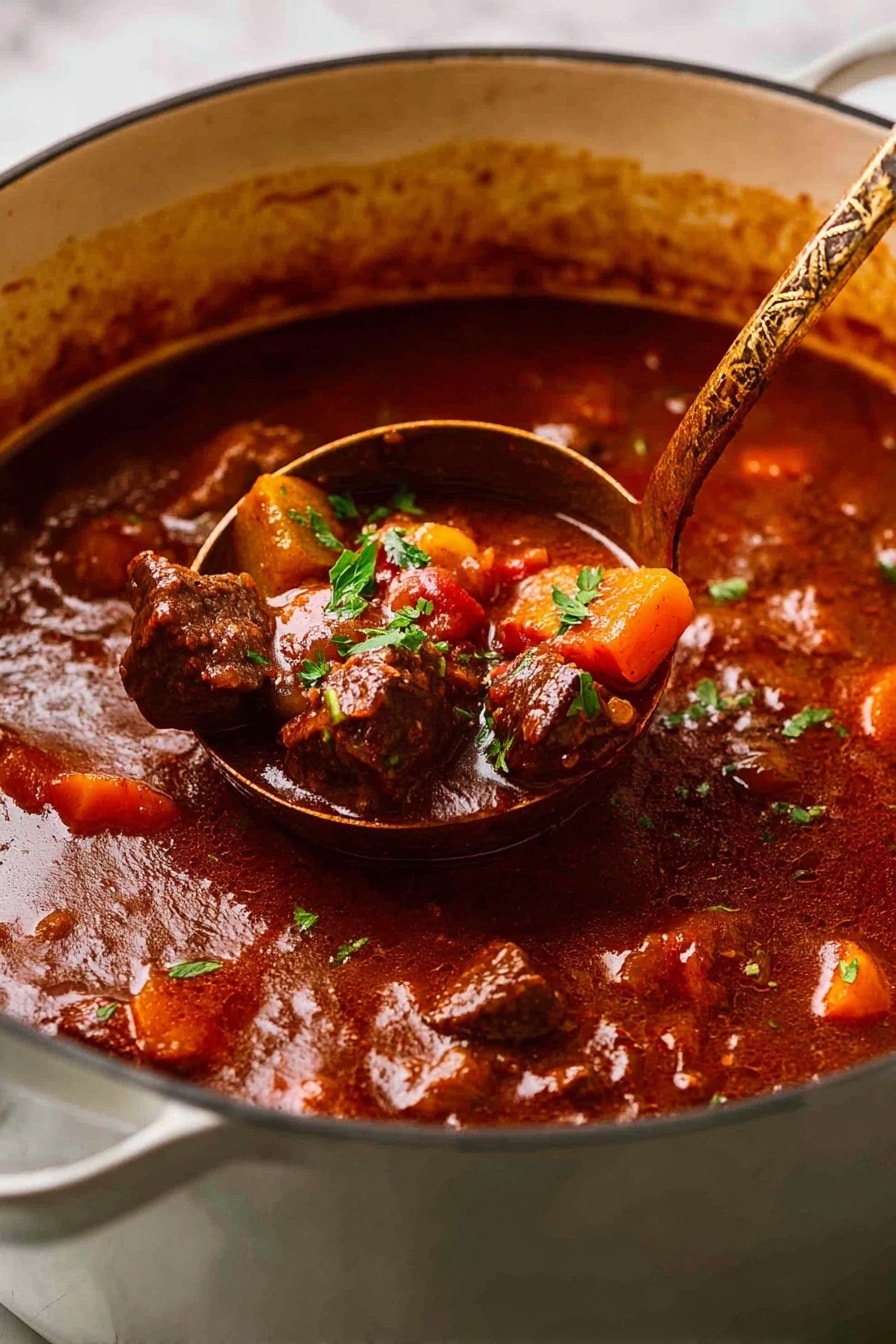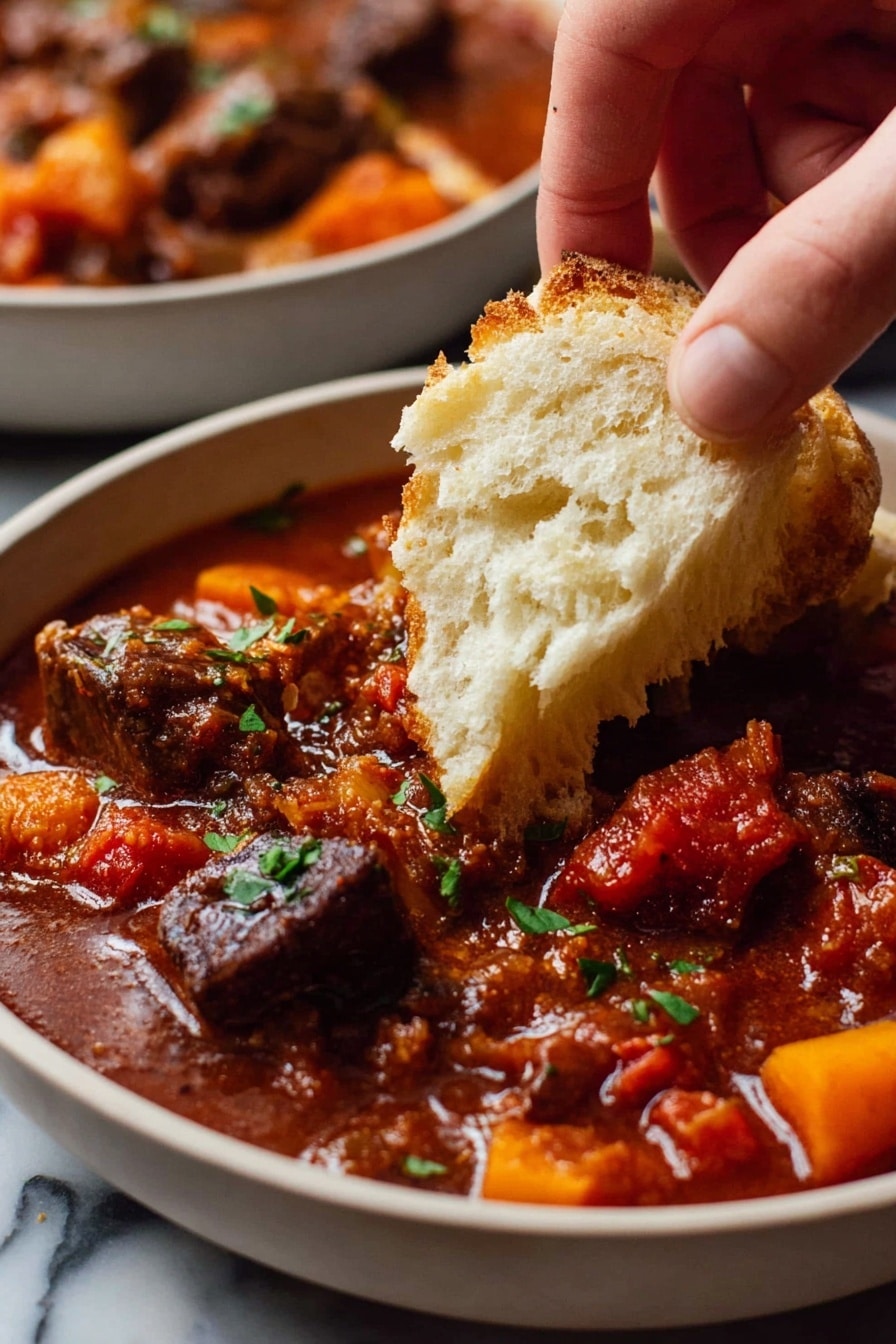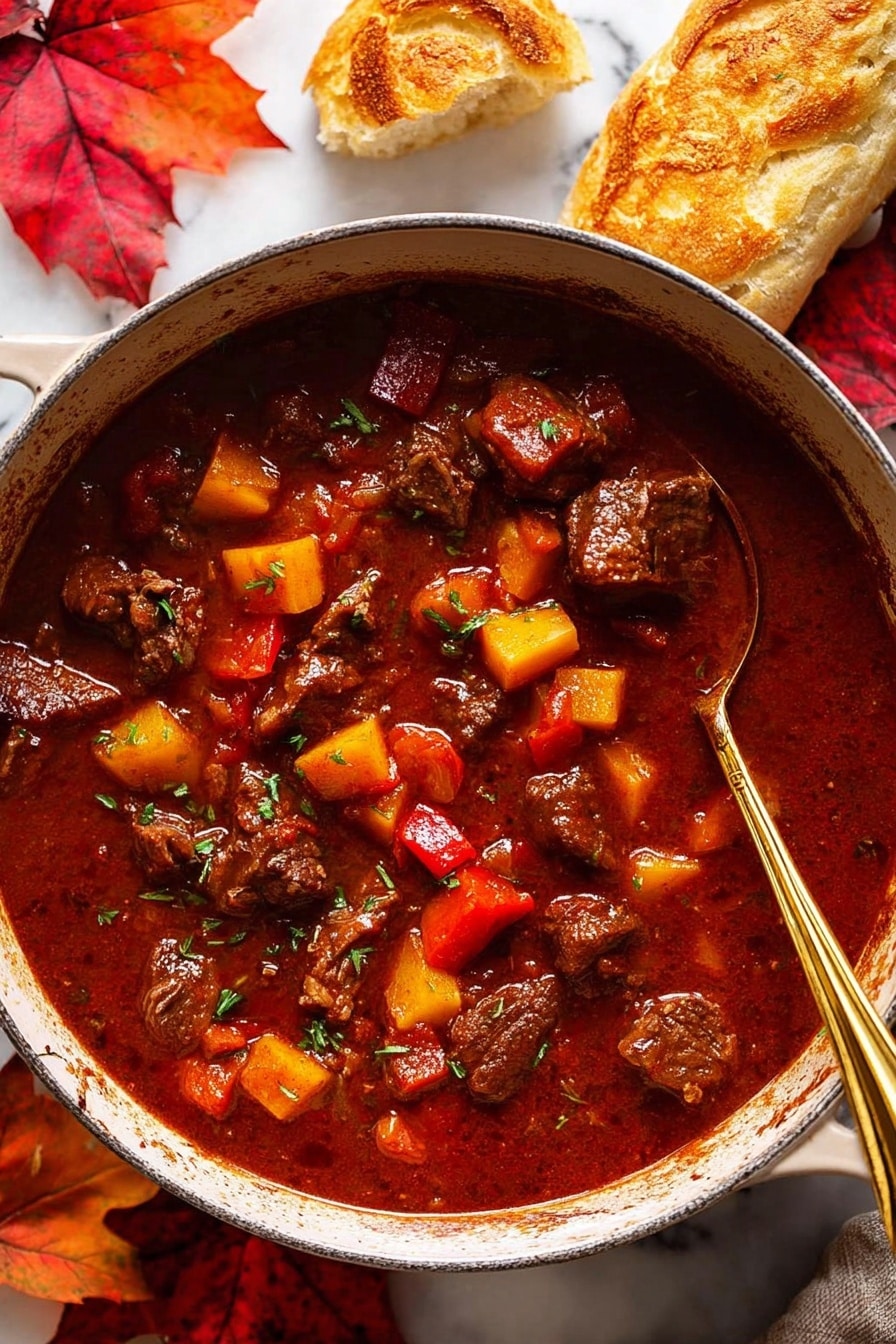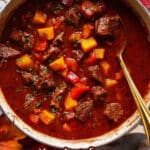If you're craving something hearty and comforting, this Hungarian Goulash (Beef Stew) Recipe hits all the right notes with tender beef, rich paprika flavors, and cozy veggies. Trust me, once you try it, it'll become your favorite stew for cool evenings.
Jump to:
Why You'll Love This Recipe
I’ve made quite a few beef stews over the years, but this Hungarian Goulash (Beef Stew) Recipe stands out every time because it’s fragrantly spiced without being overpowering and super easy to get just right. Let me share why it’s one of my go-to comfort foods.
- Rich Paprika Flavor: The star ingredient – Hungarian paprika – gives it that unmistakable smoky-sweet depth without heat, unlike your regular paprika.
- Tender, Perfectly Cooked Beef: Slow cooking softens the beef to melt-in-your-mouth goodness that’s nothing like your rushed stew attempts.
- Simple, Fresh Ingredients: No fancy hard-to-find stuff here; just quality basics that build incredible flavor together.
- Flexible Cooking Methods: Whether you prefer stove, oven, or slow cooker, this recipe adapts — I’m sharing tips for each!

Ingredients & Why They Work
Every ingredient in this Hungarian Goulash (Beef Stew) Recipe plays its role — from the paprika that defines its signature flavor to the carrots and potatoes that soak up all the delicious juices. Let’s break down why these ingredients come together so beautifully.

- Beef chuck: Perfectly marbled for slow cooking, it becomes tender and flavorful without falling apart too soon.
- Cooking salt & black pepper: The basic seasonings to enhance natural flavors; kosher salt is ideal for even seasoning.
- Extra virgin olive oil & unsalted butter: Used together for rich flavor and nice sautéed onion base without burning.
- Brown onions: Caramelize beautifully, adding sweetness that balances the paprika’s earthiness.
- Garlic cloves: Bring warmth and aromatic complexity to the stew.
- Capsicum/bell peppers: Provide a gentle crunch and freshness to complement the rich broth.
- Tomatoes: Break down to create a natural acidity that brightens the stew.
- Hungarian-style paprika: Key flavor – smoother and more vibrant than typical paprika, avoid hot paprika to keep it balanced.
- Caraway seeds: Optional but traditional, they add a subtle hint of anise-like aroma that’s classic in Hungarian cooking.
- Bay leaf: Adds a lovely background note that rounds out the flavors.
- Beef stock/broth: The liquid that ties everything together, best if low-sodium so you can control the saltiness.
- Carrots & potatoes: Hearty veggies that absorb all those wonderful flavors and provide substance.
- Parsley: Fresh garnish to lift the dish visually and flavor-wise.
Make It Your Way
One of the things I love most about this Hungarian Goulash (Beef Stew) Recipe is how flexible it is. I often tweak it depending on what’s in the fridge or my mood — and you should too!
- Spice it up: I’ve tried adding a pinch of smoked paprika for a deeper smoky kick, which I recommend if you like bold flavors.
- Vegetable swaps: If I don’t have bell peppers handy, sometimes I use mild chili or just more tomatoes for extra richness.
- Cooking time: When I’m short on time, I use the slow cooker on high for 4 hours and it still turns out wonderfully tender.
- Make it richer: Stir in a spoonful of sour cream at the end for a tangy creaminess that’s pure comfort.
Step-by-Step: How I Make Hungarian Goulash (Beef Stew) Recipe
Step 1: Season and Sear the Beef
The first step is all about flavor. I toss the beef cubes with half the salt and black pepper. This initial seasoning really helps build a tasty base. In a large oven-proof Dutch oven, I heat the olive oil and butter until shimmering, then add the beef. Remember, you want the outside to turn brown—not golden—so avoid crowding the pan to get a good sear without steaming.
Step 2: Cook the Aromatics
Next, cook the brown onions until they become soft and light golden—about 6 minutes. Add the garlic, capsicum, and tomatoes, stirring for 3 minutes until the tomatoes start to break down and everything smells amazing.
Step 3: Add Spices and Stock
Sprinkle in the Hungarian paprika, caraway seeds, and bay leaf, stirring for just 30 seconds to release their aromas. Then pour in the beef stock and bring everything to a gentle simmer.
Step 4: Slow Cook in the Oven
Cover the pot with a tight-fitting lid and pop it in your preheated oven at 180°C (350°F). After 1 ½ hours, the beef should be tender but still hold its shape; if you don’t have an oven, a low stove simmer or slow cooker works well too!
Step 5: Add Vegetables and Finish Cooking
Stir in the carrots and potatoes, then return to the oven, covered, for another 30 minutes. The beef will now soften to that fall-apart perfect texture we all crave. If it’s not quite there, simply check every 10 minutes until it’s perfect.
Step 6: Serve and Garnish
Ladle your goulash into bowls and sprinkle generously with freshly chopped parsley. I love pairing it with a crusty bread or even cheese bread to soak up that beautiful sauce.
Top Tip
This recipe has become a staple in my kitchen, and over time I've learned a few little tricks that really elevate it. I’m sharing them here so you can skip the trial-and-error and jump straight to delicious.
- Perfect Beef Texture: Don’t rush the slow cooking–the beef needs plenty of time to soften but avoid cooking too long before adding potatoes or they’ll turn mushy.
- Oil and Butter Combo: Searing onions and beef in both olive oil and butter adds a richness that straight oil-only cooking can’t match.
- Use Hungarian Paprika: I once used regular sweet paprika and noticed the stew was missing that authentic smoothness—don't skip this!
- Cover Tightly: Keeping the lid on snug traps heat and moisture, ensuring your beef becomes perfectly tender without drying out.
How to Serve Hungarian Goulash (Beef Stew) Recipe

Garnishes
I always toss on finely chopped fresh parsley. It adds a splash of color and a fresh, herbaceous note that cuts through the rich stew beautifully. Sometimes I also add a dollop of sour cream for creaminess and a tiny pop of brightness.
Side Dishes
This goulash shines with simple sides like rustic bread, buttered egg noodles, or buttery spaetzle which soak up the sauce. For a lighter touch, try steamed green beans or a crisp green salad with a sharp vinaigrette.
Creative Ways to Present
For a special occasion, I sometimes serve the goulash inside hollowed-out bread bowls, which not only look impressive but make every bite extra comforting. You could also arrange it over creamy mashed potatoes with a sprinkle of paprika on top for color!
Make Ahead and Storage
Storing Leftovers
I store leftovers in airtight containers in the fridge; this goulash actually tastes better the next day once all those flavors meld. It keeps wonderfully for about 4 to 5 days, making it perfect for meal prepping or busy weeknight dinners.
Freezing
Freezing goulash works great too — just portion it out into freezer-safe containers and it can last up to 3 months. When I pull it out, I thaw overnight in the fridge for best texture.
Reheating
Reheat gently on the stove over low heat with a splash of water or stock to keep the sauce luscious, stirring occasionally. Avoid microwaving directly from frozen as it tends to dry out the beef.
Frequently Asked Questions:
Absolutely! While I prefer using a Dutch oven for even heat and caramelization, you can use a slow cooker or a heavy-bottomed pot on the stove. Just be mindful to use low heat and stir occasionally to prevent sticking.
Yes, beef chuck is ideal for this recipe because it becomes tender and flavorful when slow cooked. But you can also experiment with beef osso bucco (boneless), beef cheeks, brisket, or gravy beef—all bring slightly different textures and richness.
If Hungarian paprika isn’t available, use a good quality sweet paprika. But try to avoid hot paprika because it can overpower the dish. Also, the traditional Hungarian paprika has a smoother, less sweet flavor than most regular paprikas, so it’s worth seeking out if you want that classic taste.
You can safely keep leftovers for about 4 to 5 days in the fridge in an airtight container. Just reheat gently, and you’ll find the flavors often deepen overnight, making leftovers even better than the first day!
Final Thoughts
This Hungarian Goulash (Beef Stew) Recipe always feels like a little hug in a bowl for me – it’s the perfect combination of hearty, flavorful, and lovingly simple. I encourage you to give it a try, let it simmer away, and enjoy the incredible aroma filling your kitchen. Invite your friends or family around; it’s the kind of dish that brings people happily together. Happy cooking!
Print
Hungarian Goulash (Beef Stew) Recipe
- Prep Time: 15 minutes
- Cook Time: 2 hours 20 minutes
- Total Time: 2 hours 35 minutes
- Yield: 5 servings
- Category: Main Course
- Method: Baking
- Cuisine: Hungarian
Description
Traditional Hungarian beef stew known as Goulash, featuring tender beef chuck slowly cooked with onions, bell peppers, tomatoes, and a rich blend of paprika and spices. This comforting dish is perfect for hearty dinners and showcases deep, comforting flavors developed through slow oven cooking.
Ingredients
Meat and Seasonings
- 1 kg beef chuck, cut in 3.5 cm cubes
- 1 ¾ teaspoon cooking salt / kosher salt
- 1 teaspoon black pepper
Cooking Fats
- 1 tablespoon extra virgin olive oil
- 2 tablespoon unsalted butter
Vegetables and Aromatics
- 2 brown onions, cut into 1 cm squares
- 5 garlic cloves, finely minced
- 2 capsicum/bell peppers (1 red + 1 yellow), cut into 2 cm squares
- 2 tomatoes, cut into 8 wedges then halved
- 2 carrots, peeled, cut in quarters lengthwise then into 1 cm pieces
- 2 potatoes, cut into 1.2 cm cubes
Spices and Broth
- ¼ cup Hungarian-style paprika
- 1 teaspoon caraway seeds, optional
- 1 bay leaf
- 1 litre beef stock/broth, low-sodium
Garnish
- 1 tablespoon finely chopped parsley, optional
Instructions
- Preheat Oven: Preheat your oven to 180°C (350°F) or 160°C if using a fan oven. This method ensures even cooking and caramelization for enhanced flavor.
- Season Beef: Toss the beef cubes with half of the cooking salt and black pepper to coat evenly.
- Cook Onions: In a large oven-proof Dutch oven, heat the olive oil and melt the butter over high heat. Add the onions and cook for about 6 minutes until the edges turn light golden brown.
- Brown Beef: Add the seasoned beef to the pot and stir for about 2 minutes until the beef changes color from red to brown; it’s not meant to brown fully but just to seal in the juices.
- Add Vegetables: Incorporate the minced garlic, bell peppers, and tomatoes into the pot. Stir continuously for 3 minutes until the tomatoes begin to break down.
- Spice It Up: Sprinkle in the Hungarian paprika, caraway seeds (if using), and add the bay leaf. Stir for 30 seconds to release the spices’ aroma.
- Simmer and Oven Cook: Pour in the beef stock, stir well, and bring to a simmer. Cover the pot with a lid and transfer it to the preheated oven. Let it cook for 1 hour and 30 minutes.
- Add Root Vegetables: After the initial cooking time, add the chopped carrots and potatoes to the stew. Cover and return the pot to the oven for an additional 30 minutes. Check the beef tenderness; it should be falling apart. If not, cook for more 10-minute intervals until desired tenderness is reached.
- Serve: Ladle the goulash into serving bowls and garnish with finely chopped parsley. Serve hot, optionally with crusty bread for dipping.
Notes
- Beef alternatives include osso bucco or beef cheeks for richer flavor. Brisket and gravy beef can be used but tend to be leaner.
- Use Hungarian or Hungarian-style paprika for smooth, authentic flavor. Avoid hot paprika as the dish already contains plenty of paprika.
- Caraway seeds add traditional Central European taste but are optional.
- Oven cooking offers caramelization and consistent heat. Stove or slow cooker methods are alternatives but require careful heat management.
- On the stove, keep heat very low and stir occasionally to prevent sticking. Cook covered for 1.5 hours before adding vegetables.
- Slow cooker method entails 6 hours on low for the initial cooking and an additional 2 hours after adding root vegetables.
- Leftovers improve in flavor after a day and can be refrigerated for 4-5 days or frozen for up to 3 months.
Nutrition
- Serving Size: 1 bowl
- Calories: 350 kcal
- Sugar: 6 g
- Sodium: 450 mg
- Fat: 17 g
- Saturated Fat: 6 g
- Unsaturated Fat: 9 g
- Trans Fat: 0 g
- Carbohydrates: 18 g
- Fiber: 4 g
- Protein: 30 g
- Cholesterol: 85 mg







Leave a Reply